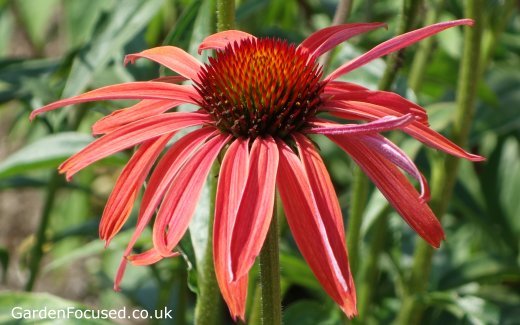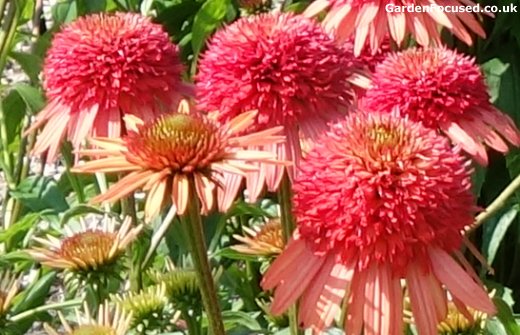ECHINACEA (CONEFLOWER)
Article by David Marks
Echinacea (also known as Coneflowers) are perennial plants which will live for many years. They can be left to their own devices for four years and may then benefit from being divided into two individual plants which will then live for many more years after that. See later in this article for more details on how to do this.
Echinacea grow naturally in prairie lands in central and eastern areas of Central America.
Use the checklist below to decide if Echinacea is suited to your preferences and garden conditions:
- They grow to roughly 90cm / 34 inches high with a spread of 45cm / 18in. Some (notably Echinacea purpurea) can reach 1.5m high.
- Leaves first appear in early April.
- Single stemmed flowers appear in late July and continue until late August or early September if conditions are good.
- The leaves die down in October / November time.
- Echinacea will grow in most soils, including acidic to alkaline soils. If planting in heavy clay, then it’s best to improve the soil condition by digging in some well rotted compost. They thrive in sandy, loam and chalk soils.
- They prefer to be in full sun but will tolerate partial shade well. The best flower colour occurs in a sunny position.
- When the base clump of foliage starts to get congested it’s best to divide the plants into three and replant.
- Echinacea are low maintenance plants. They need a moist soil for their first year but when established they will survive drought well. Removing faded flowers definitely encourages new flowers.
- No parts of the plant are poisonous to humans to our knowledge.
- They make good cut flowers but fresh stems only last for five or six days. Dried flower heads are very attractive and will look good for six months or so.
- Smaller Echinacea will grow well in deep containers, taller varieties will struggle to perform well in containers.
- Most varieties are fully hardy in all parts of the UK down to -22°C / -11°F.
WHERE TO BUY ECHINACEA
Almost all garden centres will sell Echinacea so there is no difficulty in obtaining them. However, they will only sell a limited number of varieties. They are also widely available online and the number of varieties is almost endless.
HOW AND WHEN TO PLANT ECHINACEA
Planting from pots is the quickest method as described below
- Choose a sunny position or in light shade. Somewhere where the soil is normally moist but not waterlogged.
- If the soil is heavy or is not free draining add lots of well rotted compost to the area and dig it in well.
- It can be planted all year long if the soil is not frozen and you can water well when conditions are dry. Mid March to April and mid September to October are the best times to plant potted Echinacea.
- Echinacea does not always flower well in its first year, plant in September to October for the best chance of a good display the following year.
- If planting more than Echinacea allow 30m to 45cm (12in to 18in) between each plant.
- Dig a hole twice the width of the rootball. Sprinkle in a handful of blood, fish and bone and work into the ground.
- Place the plant into the hole, filling in with soil so that it is at the same depth as was in the pot. Fill around the rootball and firm the soil down gently but firmly. Water well to settle the surrounding ground around the rootball.
HOW TO CARE FOR ECHINACEA
Echinacea are low maintenance plants when established. The tips below will help to give the best display of plants.
- In their first year keep them well watered to ensure the soil is moist but not waterlogged. From the second year onwards, only water if conditions are very dry. Echinacea have long tap roots which ensures they have adequate water in all but the driest conditions.
- In spring mulch around the plant to conserve moisture and discourage weeds.
- Feed them with a long lasting fertiliser such as fish, blood and bone in mid spring, June and August. Do not feed with nitrogen rich fertiliser which will only encourage excessfoliageeat the expense of flowers.at the expense of flowers.
- When individual flowers begin to fade, pinch them off to encourage more flowers to appear.
- In November to December time, cut the plants back to ground level.
- Flower production will decrease after three or four years. Dig the plant up, divide it into three using a sharp knife, replant one where the original plant was and plant the other two elsewhere. Water well. Divide them like this in October to ensure the roots will be kept moist by natural rainfall.
GROWING ECHINACEA IN CONTAINERS
Echinacea have log tap roots, the taller the plant grows, the longer the tap roots. So choose one of the shorter varieties such as Echinacea purpurea ‘Pink Double Delight’ or Echinacea purpurea’ Rubinglow
Because of their preference for a well drained but moist soil they will need to be watered regularly and good drainage holes in the pot or container are a must.
A 45cm / 18in wide container is about the smallest advisable. The larger the container the happier the plant will be it will require watering less frequently. A container 30cm / 12 in deep is fine but again, the deeper it is the less frequently it will need watering.
Feed your plant in spring and autumn with a good handful of fish blood and bone. It will also be beneficial to feed it once a month with a liquid plant food such as Miracle Gro or similar.
One nice container planting idea we have seen is to under plant with snow drops or daffodils. By the time your Echinacea wakes up from its winter rest the daffodils or snow drops will have died down.
PESTS AND DISEASES OF ECHINACEA
Echinacea are very strong growing and in normal conditions they are pest and disease free. The few problems you might encounter are listed below.
VINE WEEVIL
This may be a problem with plants grown in containers but Echinacea are no more susceptible than other plants. See our page here for diagnosing and treating vine weevil.
MILDEW
Occasionally Echinacea can suffer from mildew, see our page for diagnosing and treating this problem.
ECHINACEA SUMMARY
Below we list the key strengths and weaknesses of Echinacea.
| HARDY | |
| CLAY SOIL | Yes (may need improvement) |
| SANDY SOIL | Yes |
| DRY SOIL | Yes when established |
| SHADE | No |
| EVERGREEN | No |
| EASY CARE | |
| SMALL GARDENS | Yes |
| POT / CONTAINER | Yes |
| FLOWERING | |
| FLOWER TIME | Late July to early September |

